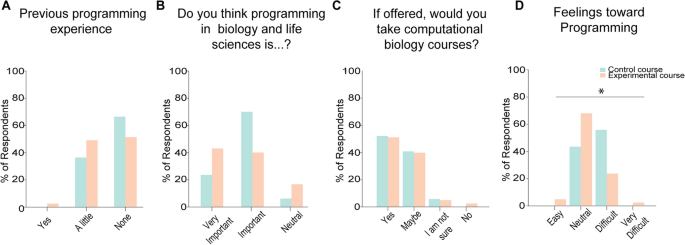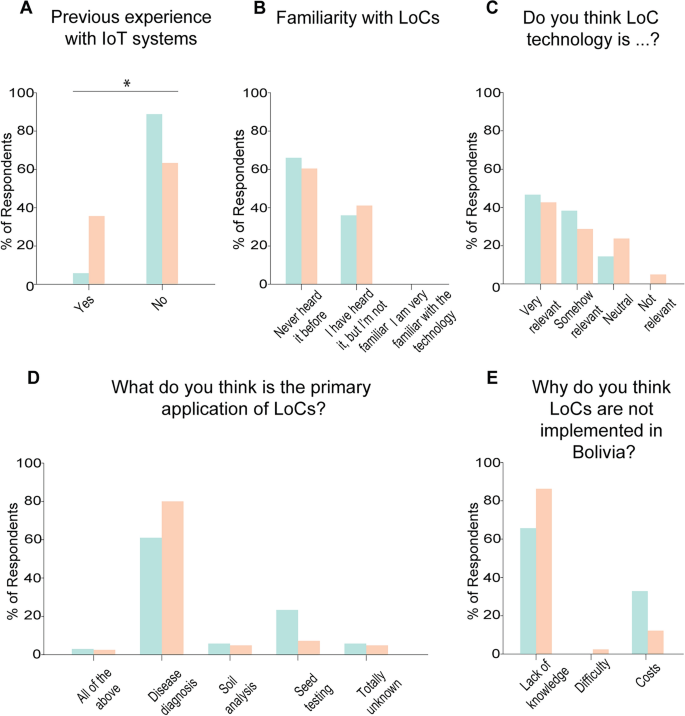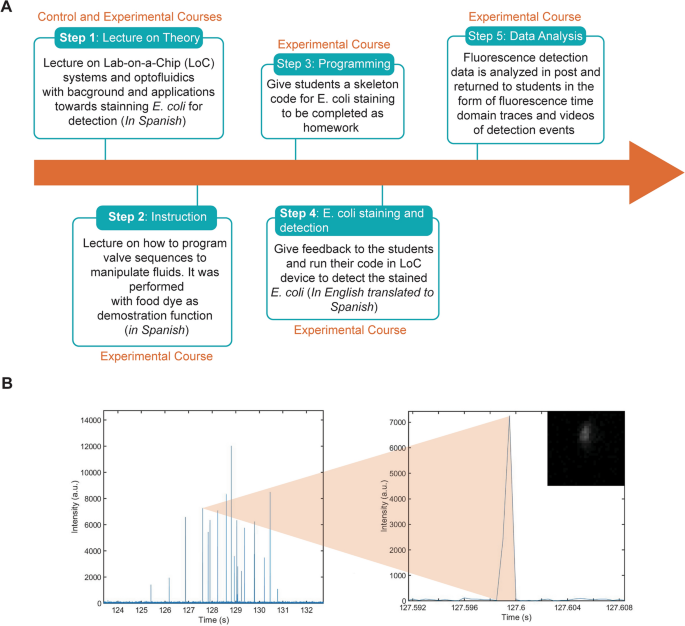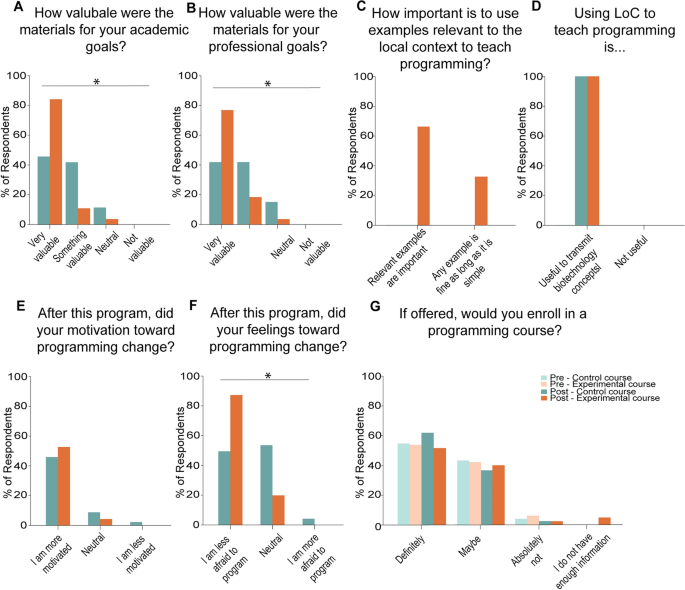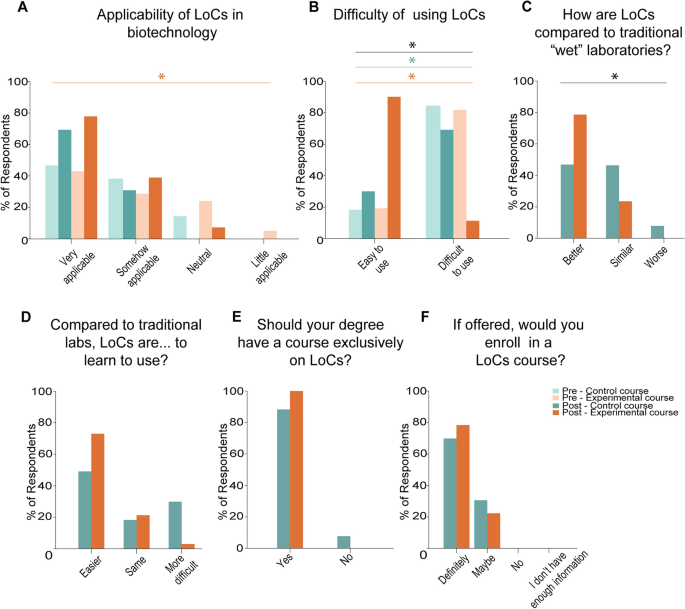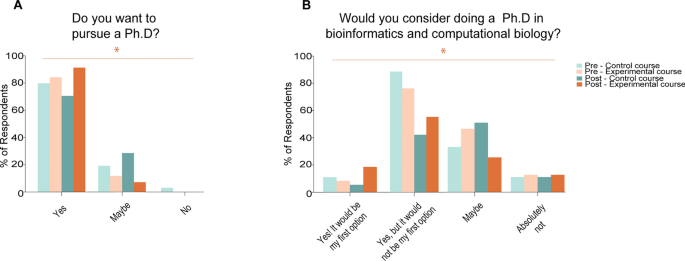An internet-enabled LoC platform allows for remote control of fluidics experiments
We developed an internet-enabled open-loop LoC platform, detailed in Fig. 1. In this platform, the LoC system, combining sample preparation and optical detection, was located within an optical setup at the University of California Santa Cruz. In this setup, an optical fiber carrying 488 nm excitation light was aligned to the solid-core excitation waveguide. Fifteen pneumatic lines connected an electronics box (Automaton) to the LoC, enabling remote pneumatic actuation and thus fluid manipulation and sample preparation.
Internet enabled lab-on-a-chip platform. (A) The polydimethylsiloxane (PDMS) LoC optofluidics device combines sample preparation and optical detection capabilities. The chip contains pneumatically-operated “lifting-gate” valves that can be controlled to move and mix liquids. An external laser is coupled to the chip via a solid core PDMS waveguide, enabling optical excitation of fluorescent biomarkers. (B) A custom written script can be uploaded from a remote location to the cloud and received by a local IoT device. An interpreter program decodes the script and operates pneumatic valves in the PDMS optofluidic device for sample preparation and optical detection.
As described in the methods section, any remote device accessing the local Raspberry PI device can conduct sequences of valve actuation to manipulate and move fluids through the device. We have included all the related code in https://github.com/braingeneers/IOT_Education_Lab_on_Chip_Paper. This platform is widely applicable for multiple experiments as the chip architecture itself can be altered as a result of the easy reconfigurability and rapid fabrication of PDMS devices. Additionally, the wavelength coupled to the excitation fiber can be changed, allowing for detection of different and multiple fluorescently labeled biomarkers. Several applications can be envisioned, ranging from traditional immunohistochemistry using antibodies, to microorganism detection. The ability to use LoC technologies in a variety of topics make them ideal tools for context-aware learning. Furthermore, the versatility of this tool allows it to reach a multitude of populations from high school students as a gateway into scientific disciplines to graduate students and researchers who need to use this tool for research. Moreover, the simplicity of the interpreter program allows this tool to be used as a first exposure to programming.
Recruited Latinx life sciences students have little programming experience as part of their training
To test the impact of our IoT-enabled LoC device in the classroom, we recruited undergraduate biotechnology students at the Universidad Católica Boliviana San Pablo (UCB). This university is the only one to offer 5-year degrees in biotechnology in Bolivia (4 years instructional and 1 year internship and thesis writing). The biotechnology curriculum at UCB does not have required courses that expose students to introductory programming concepts. The students were part of two iterations of the course, which was taught in two different academic years. In one iteration, which we referred to as the control group, the class only had a lecture component. On the other hand, in the experimental group, the class had lectures and a practical programming assignment. The control group had 34 students, while the experimental group had 42.
Because computer programming is not part of the Bolivian high school curriculum, the large majority of biotechnology students have not had previous programming experience. Nevertheless, we asked the students their level of programming experience in any language. In the control group, 67.6% of the students reported that they had never programmed before, while 32.4% of the students had minimal programming experience. Similarly, in the experimental group, 69% of students responded that they have never programmed before with the remaining 31% reporting that their previous experience with programming was minimal (p > 0.05) (Fig. 2A).
Recruited students had little programming experience. (A–D) Distribution of answers to pre-course survey questions. (A) Previous programming experience. (B) Perceived importance of programming in biology and life sciences. (C) Desire to take computational biology courses. (D) Feeling towards programming. n = 34 students in the control group and 42 students in the experimental group. * = p
Given their lack of programming experience, we asked the students whether they thought that programming was important for a career in biology and life sciences. Strikingly, we found that the large majority of students (94.1% in the control group and 83.4% in the experimental group) thought that programming was important, with 23.5% of students in the control group and 42.9% of students in the experimental group saying that it was “very important”, and 70.6% of students in the control group and 40.5% of students in the experimental group saying it was “important” (p > 0.05) (Fig. 2B). The majority of students (52.9% in the control group and 52.4% in the experimental group) said that they would take a computational biology course if it was offered by their university (p > 0.05) (Fig. 2C). We then asked the students whether they thought programming was easy or difficult. In the control group, 55.9% of the students felt that programming was difficult, while 40.1% felt neutral. In the experimental group, the large majority (69%) felt neutral on the difficulty of programming (p 2D), independently on whether they had previous programming experience or not (p > 0.05). Altogether we conclude that even though the majority of the students lack previous programming exposure, they understand the importance of programming in their careers.
Given their thoughts on programming, we asked the students how they perceived the representation of Latinx in the fields of bioengineering, as well as computational biology. We found that students thought that Latinx were underrepresented in both fields (Supplemental Fig. 1A,B). Specifically, 67.2% of students in the control group and 71.4% of students in the experimental group believed that Latinx scientists were underrepresented in computational biology (p > 0.05) (Supplemental Fig. 1A), while 64.7% of students in the control group and 66.7% of students in the experimental group thought that Latinx scientists were underrepresented in bioengineering (p > 0.05) Supplemental Fig. 1B). We then asked the students their thoughts on what are the obstacles to continue a career in computational biology. Overwhelmingly, the students said that lack of exposure is the main obstacle (44.1% control; 45.2% experimental) (Supplemental Fig. 1C). Other popular opinions included fear of programming (8.8% control; 19% experimental), and that lack of teacher training (17.6% control; 11.9% experimental) (Supplemental Fig. 1C).
Understanding that the students had little programming exposure, we asked them whether they would consider doing doctoral studies in computational biology after they finished their degree. In the control group, 32.4% of the students said “Maybe” while 52.9% of the students said they would consider doing a doctorate in computational biology, although it would not be their first choice (Supplemental Fig. 1D). On the other hand, in the experimental group, 45.2% said “Maybe”, while 38.1% of students said that they would consider doing a doctorate in computational biology, although it would not be their first choice (Supplemental Fig. 1D). Only 2 students in the control group (5.9%) and 2 students in the experimental group (4.8%) said that a doctorate in computational biology would be their first option, while 3 students in the control group (8.8%) and 5 students in the experimental group (11.9%) said they would “absolutely not” consider performing doctoral studies in this field (p > 0.05) (Supplemental Fig. 1D).
Previously, we used IoT-enabled microscopes to complement an introductory to biology course at the Universidad Católica Boliviana San Pablo3, and therefore a subset of these students have previously worked with our group, although none had worked with LoCs. To understand whether the students were familiar with IoT-enabled technologies we asked them if they had a previous experience using these IoT devices in the laboratory setting (Fig. 3A). We found that 94.1% of students in the control group and 64.3% of the students in the experimental group had no previous experience (p 3A). When asked about their familiarity with LoC technologies, 64.7% of the students in the control group and 59.5% of the students in the experimental group said that they never heard of LoC technologies before, while the rest said that they have heard of LoCs before but they were not familiar with the technology (p > 0.05) (Fig. 3B). No student in any of the groups said that they were familiar with LoC technologies (Fig. 3B). We then asked the students if they thought that LoCs were easy or hard to use. The overwhelming majority (82.4% control; 81% experimental) of students thought that LoCs were hard to use (p > 0.05) (Fig. 3C). Interestingly, most (61.8% control; 81% experimental) of the students thought that the primary use of LoCs was disease diagnosis (Fig. 3D). When asked their thoughts on why LoCs are not implemented in Bolivia, 64.7% of students in the control group and 85.6% of the students in the experimental group said that it was because of lack of knowledge, while 32.4% of students in the control group 11.9% of the students in the experimental group thought it was due to high costs (Fig. 3E).
Recruited students had little exposure to LoC systems. (A–E) Distribution of answers to pre-course survey questions. (A) Previous experience using IoT systems. (B) Familiarity with LoC systems. (C) Perception of relevance of LoC systems. (D) Perception of applications of LoCs. (E) Perceptions of difficulties for application of LoC technologies in Bolivia. n = 34 students in the control group and 42 students in the experimental group. * = p
We then asked the students if they were familiar with some of the reagents that were going to be used in our project. Specifically, we asked students if they have ever used PDMS, the primary ingredient to make our LoCs. Most students (82.4% control; 76.2% experimental) said they never used PDMS before, while 14.7% of students in the control group and 21.4% of the students in the experimental group were unsure (p > 0.05) (Supplemental Fig. 2A). Most students (82.4% control; 64.3% experimental) said they had never worked with live bacteria before (p > 0.05) (Supplemental Fig. 2B). Finally, we found that the majority of students (61.8% control; 71.4% experimental) had previously visualized DNA (p > 0.05) (Supplemental Fig. 2C). Altogether, we conclude that while the students have had little exposure to programming and LoC technologies, they acknowledged the importance of the topics in their careers. Furthermore, we can conclude that the cohorts of students had knowledge and familiarity with the technologies used in this activity.
Development of a LoC-based context-aware curriculum
We designed a training module (Fig. 4) that was based on a common issue in Bolivia and the developing world: water quality. Bolivia is a country that has a long and complicated history of water accessibility21. Specifically, in the early 2000s, major protests in Cochabamba, Bolivia, known as the “water war”, forced the retreat of multinational water companies and the creation of public water industries21. Since then several governmental policies have focused on the establishment of water as a basic human right21.
Context-aware remote training using LoC systems. (A) Training workflow. In the first lecture (taught to both groups) the students are taught the theory of LoC systems and their applications to pathogen detection. In the second lecture (taught only to the experimental group), the students are taught how to program LoC systems. Both lectures are taught in the students’ native language. The students in the experimental group are then assigned a project detecting bacteria in water samples. They then complete the assignment, upload their code and receive feedback. The LoC system is then run with their code and the data is produced, analyzed and returned to the students. (B) Example of detection of E. coli in the samples of one of the groups. Left: Detection of E. coli over 8 s. Right: Individual peak detected and corresponding E. coli bacterium that emitted the peak.
As per water quality, previous work has tracked the water quality in urban and local populations in all 3 major regions of Bolivia: the lowlands, the valleys and the highlands22. This work revealed a significant increase in water contamination from the water source to the drinking cup, using Escherichia coli (E. coli) presence as a readout of fecal contamination22. Importantly, it was determined that 64% of the water samples tested had E. coli contamination22.
Given the history of both poor accessibility to water and high water contamination rates in the country, we used water testing as a gateway into teaching. We aimed to introduce the students in the experimental group to programming by asking them to detect individual E. coli cells in water samples. To accomplish this task, the students were expected to program LoC devices and perform staining of E. coli using the dye SYBR Gold, a highly-sensitive cyanine dye that intercalates with DNA23. As part of the process, the students needed to program the valves of a LoC device to first mix the water sample with the dye, then rotate the bacteria and the dye mixture through multiple valves to accomplish homogenization, then incubate the mixture and then carry it to the optical detection device. The task could only be accomplished if the correct sequence of valves can be precisely opened and closed, therefore requiring a high level understanding of the grid and the mechanisms of operations of the LoC device.
In preparation for the project, we lectured the students via Zoom. All lectures were given outside of their official classroom times (Fig. 4A). The lectures were conducted in Spanish, the native language of the students, by M.A.M.-R., who is a native Spanish speaker. We considered that teaching in Spanish as important, as it has been previously shown that science communication is more effective when done in the students’ native languages24. In the first lecture, which was given to both groups, we introduced the students to the concept of LoC technology and the specifics of the custom-made device that we made, including its fabrication methods and previous applications of the technology (Fig. 4A). In the second lecture, which was given only to the experimental group, the students were instructed on the various coding elements used to program sequential valve operation for manipulation of fluids through the chip (Supplemental Fig. 3). Lecture material included specific examples as well as a live demonstration of how the chip can be used to mix red and blue food dye as a proxy for illustrating the mixing of assay reagents (Supplemental Video 1).
At the conclusion of the second lecture, the students in the experimental group received a redacted version of a functioning code designed to mix E. coli and fluorescent staining dye together in the valves (Fig. 4A). Their homework was to complete the redacted portions of this code (Supplemental Fig. 4). Participating students in the experimental group were combined into groups of 3 to 4 students and given 4 days to complete their homework. Each group signed up for a one hour time slot to remotely run their E. coli staining protocol. During this time, students received feedback on their homework, ran their mixing sequence, and then had their final solution passed through the optical detection region for fluorescence detection (Fig. 4A,B). These meetings were led by T.S. and M.J.N.S. who are experts in LoC systems. The meeting was in English with simultaneous translation to Spanish by J.G.-F., S.H. or S.V.-C., all of whom are native Spanish speakers. In preparation for each session, 2 μL of E. coli bacteria diluted in 1X Phosphate-buffered saline (PBS) buffer, 2 μL of 1X SYBR Gold, and 5 μL of 1X PBS buffer were loaded on top of their respective inlets and preloaded into the first valve. After the students ran their staining protocol from their remote device, the bacteria and dye were incubated in the central mixing valves for 20 min as per the SYBR Gold standard staining procedure. Once the staining period was complete, the stained bacteria were sequentially pushed to the optical detection region of the chip (Fig. 4B).
During this experiment, a high frame rate camera captured fluorescence events where stained E. coli bacteria were excited and emitted fluorescence signals (Fig. 4B). The resulting video is analyzed frame-by-frame, where the pixel intensities in the region of interest were integrated and plotted in the time domain. The resulting time domain fluorescence trace illustrated peaks in intensity if fluorescently stained bacteria were present. The time stamp associated with each event was also used to crop a 5 ms window around each event for visual confirmation of the detected event.
We evaluated the accuracy in completing the skeleton code that was given as homework. Successful groups correctly completed the skeleton code designed to fluorescently stain the E. coli bacteria samples. Based on this metric, 10 out of 11 participating groups (90.9%) successfully completed the skeleton code. The sole error was a minor fault that was easily rectified during the one-on-one session. Altogether, we generated an instructional module using IoT integrated LoC technology and implemented it in a context important to the student community in Bolivia. We conclude that this approach successfully exposed life sciences students to introductory concepts in computer programming.
Lab-on-a-chip training leads to positive perspectives on computational science
Previously, it has been shown that experimental learning approaches in biology can increase the interest in pursuing STEM and continuing scientific careers3,4,7. We therefore aimed to understand whether using this module for teaching introductory programming concepts to life sciences students can also lead to positive feelings toward STEM. We therefore surveyed the students after completing the activity. Of note, because the surveys were not mandatory, 26 of the 34 students in the control group (76.5%), and 28 of the 42 students in the experimental group (66.6%) responded to the survey. Moreover, because we did not collect identifiable information from the students, we cannot match the answers from individual students. Therefore, we refrain from making paired comparisons in pre- and post-course surveys.
First, the students were asked to evaluate the theoretical and practical parts of the course. When asked how they would evaluate the theoretical part of the class, the large majority of respondents in both groups said that it was either excellent or good (92.3% control; 100% experimental) (p 5A). We then asked the respondents in the experimental group to evaluate the programming assignment. We found that 64.3% of the respondents said it was excellent, while 32.1% said it was good and 3.6% said it was regular (Supplemental Fig. 5B). Similarly, 82.1% of the respondents in the experimental group said that the programming project was useful to solidify concepts, while the rest felt neutral (Supplemental Fig. 5C). Notably, none of the respondents indicated that the programming coursework was not useful (Supplemental Fig. 5C). Additionally, all respondents in the experimental group said that the 1:1 call to receive feedback on their programming assignment was beneficial for their understanding of the concepts (Supplemental Fig. 5D). Because the students in the control group were not assigned a programming exercise, we did not ask them these questions (Supplemental Fig. 5B–D).
Program evaluation and prospects of careers in computational biology. (A–G) Program evaluation showing the distribution of students’ responses. (A) Perception of value of the program for academic goals. (B) Perception of value of the program for professional goals. (C) Importance of using context-aware projects in teaching. (D) Perceived applicability of LoCs in teaching programming. (E) Self-reported effects on motivation to learn to program. (F) Self-reported effects on feelings toward programming. (G) Comparison of intent to enroll in a programming course before and after this program. Control group: Pre-course n = 34; Post-course n = 26. Experimental group: Pre-course n = 42; Post-course n = 28. * = p
When asked whether they thought that the materials were valuable for their academic goals, 46.7% of the respondents in the control group and 85.7% of the respondents in the experimental group said the materials were very valuable, while 42.3% of respondents in the control group and 10.7% of respondents in the experimental group said it was somehow valuable (p 5A). Similarly, 42.3% of respondents in the control group and 78.6% of the respondents in the experimental group said the materials were very valuable for their professional goals (p 5B). Altogether, we conclude that students in the experimental group perceived a higher value of the activity than students that were not exposed to programming.
We then asked the students in the experimental group how comfortable they felt doing a programming-based assignment. We found that 96.4% of the respondents felt comfortable with the coding assignment (Supplemental Fig. 5E) suggesting that our exercise was effective in introducing programming concepts. Additionally, all respondents in the experimental group said that the project used was relevant to their degree (Supplemental Fig. 5F). We found that 64.3% of the respondents in the experimental group think that using examples relevant to the local context is important to teach programming (Fig. 5C). Strikingly, all respondents in both groups said that they thought that using LoC technologies to teach programming is a good example to transmit concepts in biotechnology (p > 0.05) (Fig. 5D), illustrating the applicability of this approach. In addition, the majority of respondents (80.0% control; 96.4% experimental) said that they would recommend this program to their peers (p > 0.05) (Supplemental Fig. 5G). Altogether, we observe that the students in the experimental group found the activity as appropriate for their background and to be useful for their degrees.
Given that the experimental group reported a high level of comfort in programming after the coursework, we then analyzed whether this comfort translated to more positive feelings toward programming, and how those feelings differed from the control group. We found that 80.8% of respondents in the control group and 92.9% of respondents in the experimental group felt more motivated to deepen their knowledge of programming (p > 0.05) (Fig. 5E). Strikingly, 82.1% of the respondents in the experimental group reported that they have less fear of programming after this activity (Fig. 5F). In contrast, only 46.2% of respondents in the control group reported less fear of programming, while 50% reported no changes after the activity (p 5F). Interestingly, the overwhelming majority (96.2% control; 96.4% experimental) of the respondents thought that their degree should offer courses exclusively in computational biology (p > 0.05) (Supplemental Fig. 5H). In addition, we observed a high interest in taking computational biology classes with all respondents in the experimental group and 96.1% of respondents in the control group indicating that they would or at least would consider taking said classes (p > 0.05) (Fig. 5G). We conclude that a practical LoC-based activity reduces the fear of programming in biotechnology students.
Our survey then focused on questions regarding students’ interest in LoC technologies. We found that 96.2% of respondents in the control group and 100% of respondents in the experimental group reported that after our program they would want to learn more about LoC technologies (p > 0.05) (Supplemental Fig. 6A). We also observe that a high percentage of respondents find that LoCs are applicable to Biotechnology. Specifically, 69.2% of the respondents in the control group and 78.6% of the respondents in the experimental group thought that LoCs were highly applicable to biotechnology (p p > 0.05 control pre vs. post surveys; p > 0.05 control vs. experimental post course survey) (Fig. 6A). Remarkably, while 69.2% of respondents in the control group say that LoCs are easy to use after the course, the percentage is increased to 85.7% in the experimental group (p p p 6B). Altogether the results demonstrate that both courses lead to the perception that LoCs are easy to use, albeit at different levels. Furthermore, only the experimental course led to a perception of LoCs being applicable to biotechnology.
Context-aware experimental education led to a higher interest in LoCs. (A–F) Distribution of answers to pre- and post-course surveys. (A) Perceived applicability of LoC’s in biotechnology before and after the program. (B) Perceived difficulty of using LoCs before and after the program. (C) Perceived performance of LoCs as compared to traditional laboratories. (D) Perceived ease to learn to use of LoCs as compared to traditional laboratories. (E) Students’ interest in having a LoC-specific course in their degrees. (F) Self-reported interest to enroll in LoC-specific courses. Control group: Pre-course n = 34; Post-course n = 26. Experimental group: Pre-course n = 42; Post-course n = 28. * = p p p p
Next, we asked the students how they thought that LoCs performed compared to traditional molecular biology labs. We observed marked differences between the groups: 46.2% of the respondents in the control group found LoCs to be better than traditional labs, while another 46.2 thought that they were equal and 7.7% thought that they were worse (Fig. 6C). In the experimental group, we found that 78.6% of the respondents thought that LoCs were better than traditional labs, while the rest of the respondents thought they were equal (p 6C). 50% of respondents in the control group and 75% of the respondents in the experimental group thought that LoCs were easier to learn to use than traditional labs, while 19.2% of respondents in the control group and 21.4% of them thought that the difficulty level was similar (p 6D). Notably, 30.8% of respondents in the control group, but only 3.6% of respondents in the experimental group thought that LoCs were harder to learn than traditional labs (p 6D). When we asked them what they thought were the primary advantages of LoCs, 50% of the respondents in the control group and 42.9% of the respondents in the experimental group thought that cost reduction was the main advantage (p > 0.05) (Supplemental Fig. 6B). All respondents in the experimental group and 92.3% of respondents in the control group thought that their degree should have a course exclusively on LoCs (p > 0.05) (Fig. 6E), and the majority of them (69.2% control; 78.6% experimental) said that they were sure they would take this course if it was offered (p > 0.05) (Fig. 6F). These results allow us to conclude that while both approaches (control and experimental) increase students’ interest in LoC technologies, the experimental approach leads to more comfort in the use of LoCs as replacement to traditional molecular biology labs.
To understand the changes in the students’ outlook toward their careers, we then asked the students how important they thought programming was for a career in life sciences. In the control group, we found that 26.9% of the respondents thought that programming was very important, and 57.7% thought that it was important (Supplemental Fig. 7). On the other hand, we found that 57.1% of the respondents in the experimental group thought it was very important, while 35.7% thought it was important (p > 0.05 experimental pre vs. post course surveys; p > 0.05 control pre vs. post surveys; p > 0.05 control vs. experimental post course survey) (Supplemental Fig. 7). Remarkably, we observed a high percentage of respondents in both groups (80.8% control; 92.9% experimental) who want to pursue a doctorate after their undergraduate degrees (p p > 0.05 control pre vs. post surveys; p > 0.05 control vs. experimental post course survey) (Fig. 7A). Interestingly, after our course, most respondents in the experimental group (75%) said that they would consider doing a doctorate in computational biology, with 17.9% of them saying that it would be their first choice (Fig. 7B). In the control group, 69.2% of the respondents said they would consider doing a doctorate in computational biology, although only 7.7% said it would be their first choice (p p > 0.05 control pre vs. post surveys; p > 0.05 control vs. experimental post course survey) (Fig. 7B). Altogether, we conclude that both courses increase the perceived importance of programming among biotechnology students. However, only the experimental course increased the desire of students to continue their training toward a career in computational approaches to biology.
LoC-enabled context-aware experimental education leads to increased interest in pursuing PhDs. (A, B) Comparison of attitudes toward continuing PhD degrees before and after our programs. (A) Self-reported interest in pursuing doctoral studies. (B) Self-reported interest in pursuing doctoral studies in computational biology. Control group: Pre-course n = 34; Post-course n = 26. Experimental group: Pre-course n = 42; Post-course n = 28. * = p p
Finally, we asked the students if they had a message for the team. We found two themes among the respondents’ comments in the experimental group. One group of respondents demonstrated their excitement for their topic and their desire to learn more. Some quotes include:
-
“The classes were very interesting. I had never heard of this technology. After learning a little bit (about this technology), I want to study more programming. I feel (that learning programming) is something that would simplify many procedures.”—Translated from Experimental Respondent 1.
-
“I wish you could share this project with many other young people who are interested in science. It is really impressive work.”—Translated from Experimental Respondent 2.
-
“Here in Latin America, and especially in Bolivia, this type of technology does not exist, so I am very grateful for this experience.”—Translated from Experimental Respondent 3.
The second group of respondents in the experimental group expressed their desire to get more involved in outreach initiatives related to programming and LoCs. Some example quotes include:
-
“It is a beautiful project. (I wish you) great success in improving your work and I hope that in the future courses you can accept volunteers from different countries to develop pilot programs or experiments.”—Translated from Experimental Respondent 4.
-
“Thank you very much for giving us this opportunity and (I) wish you success in your present and future projects. Also, how can we get involved in more activities like these?”—Translated from Experimental Respondent 5.
-
“We would like to get a little more involved in the development of the planning part.”—Translated from Experimental Respondent 6.
In the control group, we found that students often mentioned that they wanted to learn more programming, although we did not find evidence of increased interest in getting more involved in LoC-based outreach activities:
-
“It is very important to understand new technologies, which is why I consider a programming course focused on biotechnology to be necessary.”—Translated from Control Respondent 1.
-
“I would love to learn programming subjects. Although it is possible to learn programming online, having a space, a guide and especially extra time to learn would be incredible.”—Translated from Control Respondent 2.
Altogether, we conclude that our approach designing a context-aware experimental learning module to expose life sciences students to introductory programming is effective at increasing their interest in the topic and LoC technologies, reduce their fear in programming, and increase their desire to continue graduate studies in computational biology.


